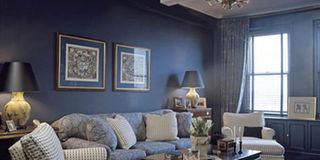Considerations for choosing paint

Dull colours make a small room appear even smaller. Therefore, choose bright colour paints for small rooms
What you need to know:
While building, paint is one of the must-haves. Paint shapes the space and sets the tone. Shabibah Nakirigya lets you in the considerations before choosing house pain
Kenneth Mutyaba, an interior décor says choosing the right paint colour for a room means balancing its architectural details against the rest of the house and creating a flow throughout the space. It is no wonder we take house paint so seriously.
Use of space
The size of the room to be painted should be your first decision because it often may restrict the colour palette you will end up using.
For a small room, choose a bright colour because they make it appear sharper and brighter.
“Choose a palette of sharper colours as opposed to duller ones. Sharp colours such as hot reds, electric blues, yellows and greens make the room appear larger.” Kenneth Mutyaba, an interior designer explains.
As with exterior paint, a lot of those choices come down to the chemical make-up of the paint you are using.
Make sure you know exactly what the space you are painting will be used for.
A lot of popular finishes these days require designing plans ahead of time, you can consult a paint professional to make sure that what looks like a matching shade in the store doesn’t come out looking odd or out of place once it is on your surfaces.
What your house say about you
While choosing house paint you have to remember that you are designing the space where you are going to live for year because some trends last for years. Others can mark your space as outdated by the time.
The important thing is finding your own visual, something that speaks to you and your family. If that includes special paint or exotic touches, go for it.
If you feel like you just might be following the herd, think about what your decisions will look like five years from now.
Different colours reflect our various personalities so keep that in mind while choosing your paint colour as this is how you will be viewed.
Basic costs
We are overly optimistic about the costs, or, even if we have been conservative, mistakes or last-minute changes can start to add up.
But before you run to the store and grab paint chips and palette books, first do the math. If you are a new home-owner, you are only just learning about the expenses that come along with your new space.
Even those who are great with money can underestimate the cost of a home improvement job.
Therefore, carefully measure the area you are going to paint. Your local store’s expert can help calculate the necessary amount of paint to buy. Once you have figured out your spending range from the measurements set aside for example money for brushes, rollers and drop cloths, decide how much you are willing to spend on paint.
Family changes
Fading paint is not the only kind of future change you should consider. Unless you enjoy redecorating on a regular basis, which some people do, look out for the latest trends and see what is coming up in the next few years.
For example, when moving from a smaller house into a large one, you are confronted with all kinds of spaces and rooms to fill with colour, and it can be tough to decide where to start.
Your house will grow with you, and your family, through all the changes and triumphs that your future holds. Planning for these possibilities is one way to make sure your house always feels like a home.
Future projects
By decorating with an eye toward the future, you can keep yourself motivated while also smoothening the transition when you finally get around to larger renovations.
For example, if your new home contains carpet or tile that you know will be gone one day, you can paint and decorate it in a way that incorporates both the current style and the one you plan to create.
Quality of light
Light transforms a room or space even more than paint does. We consider sunlight’s effects on our antiques, wall art and cushions, but sometimes we forget about the effects on the walls themselves.
Think about the room’s daily life cycle, not just your single-use ideas, and plan colors accordingly.
Colour varies according to both the quality and type of natural light and the same colour can often appear quite different from room to room, at different times of the day and even depending on the time of year.
For example, colours such as yellow and white bounce as much light around the room as possible, as will be hanging a mirror to reflect the light you do have in the space.
Health concern
No matter what it’s made of, paint is a compound of thousands of chemicals. It is scientifically designed to slide easily onto your walls and surfaces, and then harden there with exposure to air.
We have come a long way from the old lead-paint jokes, but that doesn’t mean all paint is completely nontoxic. The very nature of the product means it contains harsh and scary chemicals. But if you are concerned about indoor health risks, you should consider your family and the planet.
Inside and out
Of course, the type of paint you seek to use for depends entirely on which part of the house you want to paint.
Solvent-based paint dries more slowly, while water-based paint is easier to clean up.
If you are painting during the dry season and you feel that you may need a little more, it is best to start with a small quantity, paint a patch of wall in direct sunlight and see what happens.




